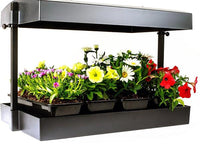How Does the Kratky Method Work?
The Kratky Method was developed by Dr. Bernard Kratky, a horticulturist from the University of Hawaii. His experiments involved veggie crops like lettuce, but his method works with cannabis and many other plants.
The reason many bucket hydroponics systems use air circulators (bubblers) is because roots need oxygen.
When oxygen is plentiful, the roots absorb nutrients more easily. When it’s not, they not only absorb fewer nutrients, but the plant also creates stress hormones. The combo of malnutrition and stress hormones destroys the immune system of the plant.
Worms aerate the soil in conventional gardens by loosening it up. This allows the roots to breathe. When the roots are in water instead of soil, they cannot get enough oxygen from the water without a circulator moving air through the water.
Dr. Kratky found a simple way around this problem. His hydroponics method forces the plants to create more than one root system. The Kratky Method creates roots that specialize in specific tasks: water-gathering, nutrient-absorption, or oxygen-absorption.
Advantages of Simple Kratky Method DIY Bucket Systems:
Easy to Set Up
You can teach a 5-year-old to do this.
Highly Affordable
The materials cost almost nothing.
Conserves media
Each plant is in a separate bucket. Using a non-bucket system, if you need a lot of space between plants, there will be a lot of media between the plants. A bucket system allows you to spread the individual plants away from each other.
Makes Pest & Disease Control Easier
If one bucket gets infected, you can quickly remove it from the area so that the nasties don’t spread.
It’s Scalable
You can make as many of these 1-bucket systems as you have room for. You won’t need more power outlets or power strips because nothing requires electricity except your lighting sources if you’re growing indoors.
No Need to Fear Power Outages
If a storm comes through and knocks out your power, the plants will keep on drinking.
How to Make a Simple Bucket Hydroponics System Using for the Kratky Method
You will need:
- 5-Gallon bucket with optional lid
- 8-inch or 10-inch hydroponic net cup instead of a bucket lid (aka net pot or net basket) OR…
- Smaller hydroponic net cup(s) (you’ll need the bucket lid for this)
- Rock wool with seedlings growing in it
- Perlite, Hydroton, or another growing medium
Step 1: Make Your Bed
If you use an 8-inch or 10-inch net cup: It should fit snugly over the 5-gallon bucket. If you do this, you won’t need the bucket lid.
If you use a smaller net cup or multiple net cups: You will need a lid for the bucket. For cannabis, don’t use a net cup smaller than three inches in diameter for one plant.
Cut a round hole in the center of your bucket lid. It should be the same diameter as the bottom of your net cup. You’ll likely need to widen this hole, little by little, until your net cup is fully in. Only the widest part of the cup will rest on the bucket lid.
For many types of crops, you can cut up to four smaller holes into the lid instead of one big one. Space them apart wisely. Three inch net cups are usually fine for larger plants. One inch is fine for small ones.
That’s a buttload of work, right?
If you’re growing cannabis, just use a 10-inch net cup and save yourself a lot of work. You’ll probably only want one big plant in there anyway.
If your bucket is not opaque, then you will need to paint it, This prevents algae and other nasty stuff from growing in your system.
Step 2: Fill Your Net Cup(s)
By now, hopefully you have seedlings growing in rock wool that you can place in your net cups. Each net cup receives one plant.
To support the roots of each plant, you want to put a growing medium in the cup. Perlite and hydroton are both popular choices. Both are pH neutral. Some prefer to use gravel, coconut fiber, or clay pellets.
Whatever you choose, fill it high enough so that the plant won’t fall over as it grows. Pretend that it’s soil.
Make sure your bucket can breathe. If you fill the net cups all the way, air won’t be able to enter the bucket.
Step 3: Add Your Nutrient Solution
In a Kratky Method system, you don’t want to fill your bucket with solution that goes all the way up to the bottoms of the net cups. Make your plants work for their supper. The bottoms of the net cups should be ½ inch higher than the solution.
It could take up to a few days for the roots to stretch out of the net cups and reach the solution. You can wet the roots in the meantime so that they don’t dry out.
Step 4: Let the Plant(s) Deplete the Water
The more nutrient solution the plant drinks, the more oxygen that enters the system. The water level will get lower and lower, making more room for air.
That’s the Kratky Method in a nutshell.
This process will cause the plants to make a set of roots for water and nutrients and another set for oxygen. You will notice the difference between these roots just by looking at them.
Step 5: Replace the Nutrient Solution
Normally, you want to replace the nutrient water in a Kratky system when the bucket is almost empty. However, a 5-gallon bucket is pretty tall. It’ll take a while for your plants to drink that much water.
Every week or so, you can dump out the solution and replace it with new solution.
There are some guidelines you need to follow, though.
You do not want to fill the bucket as high as you did the first time or you’ll drown the oxygen roots. Never fill it higher than the midpoint between the bottom of the bucket and the bottom of the net pots.
If you can visually distinguish between oxygen roots and the lower roots, then fill the bucket to some point below the oxygen roots. Use the proper nutrient ratios in your solution.
Highly Recommended: Keep Optimum pH and EC Levels
You want to keep the pH level of your nutrient solution at somewhere between 5.5 and 6.5 for this type of hydroponics system.
Use a pH meter to check your pH levels. Do this before filling multiple buckets so you won’t have to adjust each one individually.
Use pH Up by X Nutrients to raise the pH.
Use pH Down by X Nutrients to lower the pH.
Another important metric to measure is the electrical conductivity (EC) of your solution.















2 comments
Eric
Is it possible to start a melon seed in 1"rockwool, once seed has sprouted enough, put that 1" rockwool in a 6" rockwool block and then in a 5 Gal bucket with 2gal of water ?
In an apartment with no space or privacy. Using grow tent.
dominic
i have a question. I am trying to grow in a 5 gallon bucked outdoors and the bucket fills with water. How to prevent this.
Thanks
Dominic